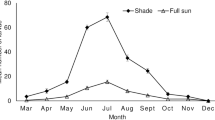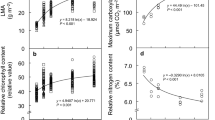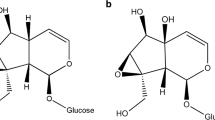Abstract
Increasing evidence suggests that the responses of insect herbivores to environment-mediated changes in the phenotypic and phytochemical traits of their host plants are more complex than previously thought. Here, we examined the effects of habitat conditions (shaded versus full-sun habitats) on plant traits and leaf characteristics of the invasive alien plant, Chromolaena odorata (L.) (Asteraceae). We also determined neonate larval preference of the specialist herbivore, Pareuchaetes pseudoinsulata Rego Barros (Lepidoptera: Erebidae) (a biological control agent) for shaded versus full-sun leaves. The study further evaluated the performance of the moth on C. odorata leaves obtained from both shaded and full-sun habitats. Leaves of C. odorata plants growing in the shaded habitat had higher water and nitrogen contents compared with full-sun leaves. Plants growing in shade had longer leaves but full-sun plants were taller and had greater aboveground biomass compared with shaded plants. Although neonate larvae of P. pseudoinsulata preferred to feed on full-sun foliage, development was faster when reared on shaded foliage. However, survival, pupal mass, growth rate, and Maw’s host suitability index of the moth did not significantly differ between full-sun and shaded foliage. Our inability to demonstrate significant differences in key insect performance metrics in P. pseudoinsulata between shaded and full-sun foliage, despite neonate larval preference for one of the foliage types, suggests that neither of the foliage types can be considered a superior host, and reiterate the fact that relationships between host plant quality (modulated by light intensity) and phytophagous insect performance are not simple.


Similar content being viewed by others
References
Abbot I, Wills A, Burbidge T, Van Heurck P (2000) Arthropod faunas of crowns of jarrah (Eucalyptus marginata) and marri (Carymbia calophylla) in Mediterranean-climate forest: a preliminary regional scale comparison. Austral Forestry 63:21–26
Benrey B, Denno RF (1997) The slow growth-high mortality hypothesis: a test using the cabbage butterfly. Ecology 78:987–999
Boersma M, Elser JJ (2006) Too much of a good thing: on stoichiometrically balanced diets and maximal growth. Ecology 87:1325–1330
Braimah H, Ekyem SO, Issah US, Mochiah M (2013) Social perceptions and ecological impacts following biological control of Chromolaena odorata by Pareuchaetes pseudoinsulata in the forest region of Ghana. In: Zachariades C, Strathie LW, Day MD, Muniappan R (eds) Proceedings of the Eighth International Workshop on Biological Control and Management of Chromolaena odorata and other Eupatorieae, Nairobi, Kenya, 1–2 November 2010. Agricultural Research Council – Plant Protection Research Institute, Pretoria, pp 110–116
Cock MWJ, Holloway JD (1982) The history of, and prospects for, the biological control of Chromolaena odorata (Compositae) by Pareuchaetes pseudoinsulata Rego Barros and allies (Lepidoptera, Arctiidae). Bull Entomol Res 72:193–205
Connor EF (2006) Effects of the light environment on oviposition preference and survival of a leaf-mining moth, Cameraria hamadryadella (Lepidoptera: Gracillariidae), on Quercus alba L. Ecol Entomol 31: 179–184
Cowie BW, Byrne MJ, Witkowski ETF, Venter N (2016) Exacerbation of photosynthetic damage through increased heat–light stress resulting from Gargaphia decoris sap-feeding. Biol Control 94:82–89
Crone EE, Jones CG (1999) The dynamics of carbon nutrient balance: effects of cottonwood acclimation to short- and long-term shade on beetle feeding preferences. J Chem Ecol 25:635–656
Cruttwell RE (1972) The insects of Eupatorium odoratum L. In: Trinidad and their potential as agents for biological control. PhD Dissertation, University of the West Indies, Trinidad
Diaz R, Aguirre C, Wheeler GS, Lapointe SL, Rosskopf E, Overholt WA (2011) Differential performance of Tropical Soda Apple and its biological control agent Gratiana boliviana (Coleoptera: Chrysomelidae) in open and shaded habitats. Environ Entomol 40:1437–1447
Fordyce JA, Shapiro AM (2003) Another perspective on the slow-growth/high-mortality hypothesis: chilling effects on swallowtail larvae. Ecology 84:263–268
Huberty AF, Denno RF (2006) Consequences of nitrogen and phosphorus limitation for the performance of two planthoppers with divergent life-history strategies. Oecologia 149:444–455
Ingersoll CM, Niesenbaum RA, Weigle CE, Lehman JH (2010) Total phenolics and individual phenolic acids vary with light environment in Lindera benzoin. Botany 88:1007–1010
Ivens GW (1974) The problem of Eupatorium odoratum L. in Nigeria. Pest Artic News Summ 20:76–82
Jansen MPT, Stamp NE (1997) Effects of light availability on host plant chemistry and the consequences for behaviour and growth of an insect herbivore. Entomol Exp Appl 82:319–333
Jiménez MIG, Sarmiento CE, Diaz MF, Chauta A, Peraza A, Ramirez A, Poveda K (2014) Oviposition, larval preference, and larval performance in two polyphagous species: does the larva know best? Entomol Exp et Appl 153:24–33
Kyi A, Zalucki MP, Titmarsh IJ (1991) An experimental study of early stage survival of Helicoverpa armigera (Lepidoptera: Noctuidae) on cotton. Bull Entomol Res 81:263–271
Landsberg J, Gillieson DS (1995) Regional and local variation insect herbivory, vegetation and soils of Eucalypt associations in contrasted landscape positions along a climatic gradient. Aust J Ecol 20:229–315
Lincoln DE, Mooney HA (1984) Herbivory on Diplacus aurantiacus shrubs in sun and shade. Oecologia 64:173–176
Louda SM, Dixon PM, Huntly HJ (1987a) Herbivory in sun versus shade at a natural meadow-woodland ecotone in the Rocky Mountains. Vegetatio 72:141–149
Louda SM, Dixon PM, Huntly HJ (1987b) Insect herbivory across a sun shade gradient—response to experimentally induced in situ plant stress. Acta Oecologica 8:357–363
Herms DA. WJ Mattson (1992) The dilemma of plants: to grow or defend. Q Rev Biol 67:283–335
Maw MG (1976) Biology of the tortoise beetle, Cassida hemisphaerica (Coleoptera: Chrysomelidae), a possible biological control agent for bladder campion, Silene cucubalus (Caryophyllaceae), in Canada. Can Entomol 108:945–954
McFadyen RE (1997) Parasitoids of the arctiid moth Pareuchaetes pseudoinsulata (Lepidoptera: Arctiidae), an introduced biocontrol agent against the weed Chromolaena odorata (Asteraceae), in Asia and Africa. Entomophaga 42:467–470
Minkenberg OPJM, Ottenheim, JJGW (1990) Effect of leaf nitrogen content of tomato plants on preference and performance of a leaf mining fly. Oecologia 83:291–298
Moore LV, Myers JH, Eng R (1988) Western tent caterpillars prefer the sunny side of the tree but why? Oikos 51:321–326
Moran PJ, Showler AT (2005) Plant responses to water deficit and shade stresses in pigweed and their influence on feeding and oviposition by the beet armyworm (Lepidoptera : Noctuidae). Environ Entomol 34:929–937
Muller O, Hirose T, Werger MJA, Hikosaka K (2011) Optimal use of leaf nitrogen explains seasonal changes in leaf nitrogen content of an understorey evergreen shrub. Ann Bot (Lond) 108:529–536
Muniappan R, Sundaramurthy VT, Virktamath CA (1989) Distribution of Chromolaena odorata (Asteraceae) and bionomics and utilization of food by Pareuchaetes pseudoinsulata (Lepidoptera: Arctiidae) in India. In: Delfosse ES (ed) Proceedings of the Seventh International Symposium on Biological Control of Weeds, 6–11 March, 1988, Rome, pp 401–409
Muth NZ, Kluger EC, Levy JH, Edwards MJ, Niesenbaum RA (2008) Increased per capita herbivory in the shade: necessity, feedback, or luxury consumption? Ecoscience 15:182–188
Onoda Y, Westoby M, Adler PB, Choong AMF, Clissold FJ et al (2011) Global patterns of leaf mechanical properties. Ecol Lett 14:301–312
Osier TL, Jennings SM (2007) Variability in host plant quality for the larvae of a polyphagous insect folivore in midseason: the impact of light on three deciduous sapling species. Entomol Exp Appl 123:159–166
Paterson ID, Zachariades C (2013) ISSRs indicate that Chromolaena odorata invading southern Africa originates in Jamaica or Cuba. Biol Control 66:132–139
Patrick K, Olckers T (2014) Influence of shade on the persistence of Gargaphia decoris (Tingidae), a biological control agent of Solanum mauritianum (Solanaceae) in South Africa. Afr Entomol 22:891–895
Pearcy RW, Muraoka H, Valladares F (2005) Crown architecture in sun and shade environments: assessing function and trade-offs with a three-dimensional simulation model. New Phytol 166:791–800
Potter DA (1992) Abundance and mortality of a specialist leafminer in response to experimental shading and fertilization of American holly. Oecologia 91:14–22
Read J, Stokes A (2006) Plant biomechanics in ecological context. Am J Bot 93:1546–1565
Roberts MR, Paul ND (2006) Seduced by the dark side: integrating molecular and ecological perspectives on the influence of light on plant defence against pests and pathogens. New Phytol 170:677–699
Rowe WJ, Potter DA (2000) Shading effects on susceptibility of Rosa spp. to defoliation by Popillia japonica (Coleoptera: Scarabaeidae). Environ Entomol 29:502–508
Scriber JM, Slansky F Jr (1981) The nutritional ecology of immature insects. Annu Rev Entomol 26:183–211
Seibert TF (1989) Biological control of the weed, Chromolaena odorata (Asteraceae) by Pareuchaetes pseudoinsulata (Lepidoptera: Arctiidae) in Guam and the Northern Mariana Islands. Entomophaga 35:531–539
Sipura M, Tahvanainen J (2000) Shading enhances the quality of willow leaves to leaf beetles—but does it matter? Oikos 91:550–558
Steinbauer MJ (2001) Specific leaf weight as an indicator of juvenile leaf toughness in Tasmanian bluegum (Eucalyptus globulus ssp. globulus): implications for insect defoliation. Austr For 64:32–37
Timbilla JA, Zachariades C, Braimah H (2003) Biological control and management of the alien invasive shrub, Chromolaena odorata in Africa. In: Neuenschwander P, Borgemeister C, Langewald J (eds) Biological control in IPM systems in Africa. CAB International, London, pp 145–160
Titmarsh IJ (1992) Life table studies of Helicoverpa species on the Darling Downs. PhD Dissertation. University of Queensland, Brisbane
Trumbule RB, Denno RF (1995) Light intensity, host-plant irrigation, and habitat-related mortality as determinants of the abundance of azalea lace bug (Heteroptera: Tingidae). Environ Entomol 24:898–908
Uyi O (2008) Evaluation of the biological control of Chromolaena odorata (L.) (Asteraceae: Eupatorieae) by Pareuchaetes pseudoinsulata (Lepidoptera: Arctiidae) in southern Ghana. Unpubl. M. Phil. Dissertation, University of Ghana, Legon
Uyi OO, Igbinosa IB (2013) The status of Chromolaena odorata and its biocontrol in West Africa. In: Zachariades C, Strathie LW, Day MD, Muniappan R (eds) Proceedings of the Eighth International Workshop on Biological Control and Management of Chromolaena odorata and other Eupatorieae, Nairobi, Kenya, 1–2 November 2010. Agricultural Research Council—Plant Protection Research Institute, Pretoria, pp 86–98
Uyi O, Egbon IN, Igbinosa IB (2011) Discovery of, and studies on Pareuchaetes pseudoinsulata (Lepidoptera: Arctiidae) in southern Nigeria. Int J Trop Insect Sci 31:199–203
Uyi OO, Ekhator F, Ikuenobe CE, Borokini TI, Aigbokhan EI, Egbon IN et al (2014a) Chromolaena odorata invasion in Nigeria: a case for coordinated biological control. Manag Biol Invasions 5:377–393
Uyi OO, Hill MP, Zachariades C (2014b) Variation in host plant has no effect on the performance and fitness-related traits of the specialist herbivore, Pareuchaetes insulata. Entomol Exp Appl 153:64–75
Uyi OO, Zachariades C, Hill MP, Conlong D (2015) The nocturnal larvae of a specialist folivore perform better on Chromolaena odorata leaves from a shaded environment. Entomol Exp Appl 156:187–199
Uyi OO, Zachariades C, Hill MP (2016) Nitrogen fertilization improves growth of Chromolaena odorata (Asteraceae) and the performance of the biological control agent, Pareuchaetes insulata (Erebidae). Biocontrol Sci Technol 26:373–385
Wheeler GS (2003) Minimal increase in larval and adult performance of the biological control agent Oxyops vitiosa when fed Melaleuca quinquenervia leaves of different nitrogen levels. Biol Control 26:109–116
Williams IS (1999) Slow-growth, high-mortality—a general hypothesis, or is it? Ecol Entomol 24: 490–495
Zachariades C, Day M, Muniappan R, Reddy GVP (2009) Chromolaena odorata (L.) King and Robinson (Asteraceae). In: Muniappan R, Reddy GVP, Raman A (eds) Biological Control of Tropical Weeds Using Arthropods. Cambridge University Press, Cambridge, pp 130–160
Zalucki MP, Malcolm SB, Paine TD, Hanlon CC, Brower LP, Clarke AR (2001) It’s the first bites that count: Survival of first-instar monarchs on milkweeds. Austral Ecol 26:547–555
Zehnder CB, Hunter MD (2009) More is not necessarily better: the impact of limiting and excessive nutrients on herbivore population growth rates. Ecol Entomol 34: 535–543.
Zhang LL, Wen DZ (2009) Structural and physiological responses of two invasive weeds, Mikania micrantha and Chromolaena odorata to contrasting light and soil water conditions. J Plant Res 122:69–79
Acknowledgements
We thank Ms. Nontembeko Dube of the ARC-Plant Protection Research Institute, South Africa, and another anonymous reviewer for comments on the previous version. We also thank Ms. Eseosa J. Uyioghosa of the Department of Animal and Environmental Biology, University of Benin, Benin City, Nigeria, for assistance during the fieldwork.
Author information
Authors and Affiliations
Corresponding author
Additional information
Handling editor: Livy Williams.
Rights and permissions
About this article
Cite this article
Uyi, O.O., Uwagiahanor, B.I. & Ejomah, A.J. The nocturnal larvae of a specialist folivore prefer Chromolaena odorata (L.) foliage from a sunny environment, but does it matter?. Arthropod-Plant Interactions 11, 603–611 (2017). https://doi.org/10.1007/s11829-017-9504-x
Received:
Accepted:
Published:
Issue Date:
DOI: https://doi.org/10.1007/s11829-017-9504-x




